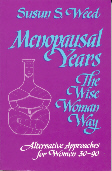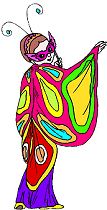“If you let that fiery wise blood just sit there in your belly,
great granddaughter,” admonishes Grandmother Growth, “you'll
get the urge to quench that heat. You'll get a tickle, a twinge, an
urgent call. But you won't have the moisture you need. It's boiled away.
It's gone up in steam.
“So I'll say it once more: circulate your wise blood,
granddaughter. Spiral it around and up to your crown. Take action on
your anger. Pleasure yourself. And you'll be one of those old crones,
like me, whose eyes sparkle with mirth and flash with intention.”
Bladder infections are also known as cystitis, urethritis,
and UTIs (urinary tract infections). When bacteria grow in the bladder,
the resulting infection usually causes symptoms such as: a burning sensation
during voiding, overwhelming urgency, frequent but minuscule urinations,
incontinence, bloody urine, and pelvic pain. Up to 25 percent of bladder
infections in post- menopausal women are silent or symptomless.
Bacteria enter the bladder in three primary ways: when
feces are spread to the bladder opening (such as wiping from back to
front after toileting), when the tube leading to the bladder is irritated
or bruised (as from use of a diaphragm, pelvic surgery, or prolonged/vigorous
vaginal penetration), or when there is an in-dwelling catheter.
The thinning and shrinking of reproductive and bladder
tissues that may occur in the post- menopausal years contributes to
bladder infections in older women, as does lessening of vaginal acidity.
Sometimes tiny ulcerations appear in the wall of the bladder;
this is called interstitial cystitis (IC). Some of the remedies in this
section are contraindicated for women with interstitial cystitis. (IC
remedies on pages XXX-XXX.)
These remedies are substantially the same ones that delighted
and aided the readers of my first book: Wise Woman Herbal for the Childbearing
Year.
• Flow, flow, flow. Head off that bladder infection
by drinking a glass of water hourly as soon as you feel the first urgency
or burning. It is tempting to stint on drinking if you find yourself
unexpectedly incontinent, but don't. Bladder infections only make incontinence
worse.
• Urine is ideally neutral to slightly acidic (pH
5.8–pH 7). Very acidic urine (below pH 5.5) encourages infections.
An established infection gives rise to alkaline urine (pH 7.5 or higher)
which causes stinging and burning. Test your urine with pH paper at
any time except first thing in the morning. Cranberry juice lowers pH;
vitamin C raises it.
• Cantharis is a homeopathic remedy for scalding
urine.
• Cranberries (Vaccinium macrocarpon) contain substances that kill
bacteria and make your bladder wall so slippery that any escaping bacteria
can't latch on and thrive there. Unsweetened cranberry juice (or concentrate)
is the most effective form. (The sugar or corn syrup in cranberry cocktail-type
juices and cran-apple juices can feed the infection.)
Drink freely, at least a glass a day, up to a quart/liter
a day for acute infections unless your urine's pH is already low.
~ Pelvic floor exercises help prevent and relieve bladder
infections too! See page XXX and try this one: After urinating, close
your eyes, relax, breathe out, and see if you can squeeze out an extra
dribble.
• An overgrowth of vaginal yeast may be irritating
your bladder or urethra. Eat one cup of plain yogurt 4-5 times a week.
~ Uva Ursi (Arctostaphylos uva ursi) is an old favorite
for strengthening the bladder and ending chronic silent bladder infections.
I prefer a hot water infusion of the dried leaves, but know women who
have successfully used cold water infusions, tinctures, even vinegars.
A dose is 1 cup/125 ml of infusion; 10-30 drops of tincture; 1 tablespoonful/15
ml of vinegar; 3–6 times a day initially, then 1–3 times a
day for 7–10 days. In very chronic cases, eliminate all forms of
sugar (even fresh fruit, fruit juice, and honey) for a month as well.
~ Yarrow is a urinary disinfectant with a powerful antibacterial
action and an astringent effect. A small cup of the infusion, once or
twice a day for 7–10 days, tones up weak, lax bladder tissues.
Combines well with uva ursi. Results may be felt within hours.
~ In my experience, Echinacea purpurea and E. augustifolia
are as effective as antibiotics in clearing bladder infections and do
not contribute to vaginal yeast. (See Step 5b.) A dose is 1 drop echinacea
tincture per 2 pounds/1 kilo body weight. (For 150 pound/70 kilo person,
use 75 drops or three dropperfuls.) In acute cases, I give the dose
every 2 hours. As the infection clears, I lengthen the amount of time
between doses until I'm down to 1–2 doses a day, which I continue
for another 2–10 weeks.
• Women who wash their vulva with soap and water
are four times more likely to get vaginal and bladder infections. Douches,
bubblebaths, tampons, nylon underwear, and pantyhose may also irritate
the urethra and contribute to bladder infections.
• Known bladder irritants include: alcohol, black
tea, coffee, sodas, citrus juices, chocolate, cayenne, and hot peppers.
(An herbal tincture in an alcohol base won't irritate the bladder if
you take it diluted in a glass of water or a cup of herb tea.)
•Urinating after love play flushes out bacteria and
cuts down on UTIs. Urinating before love play increases your risk of
a bladder infection.
• Ascorbic acid wrings the kidneys, flushes the bladder,
and raises urinary pH. Try 500 mg hourly for 6–8 hours. (IC sufferers
— avoid!)
• Be careful about taking calcium supplements if
you are prone to bladder infections. Calcium supplements increase bacterial
adherence to the bladder wall, increasing bladder infections.
• Antibiotics are the standard medical treatment
for women with bladder infections. But taking antibiotics frequently
causes vaginal yeast overgrowth (which can lead to bladder infection).
One — nitrofurantoin (Macrodantin) — seems to cause microscopic
scarring and ulceration of the bladder wall, precipitating IC.
• Dilation of the urethra is expensive, painful,
and causes tiny scars on the urethra which may lead to interstitial
cystitis. I have seen it referred to as “the rape of the female
urethra.” No controlled study has shown this procedure to be effective
at limiting chronic bladder infections. Do pelvic floor exercises instead.
This excerpt, from Susun Weed's New Menopausal Years the Wise
Woman Way,
Alternative Approaches for Women 30-90, is from the section
on Vaginal/Bladder Changes, which also includes help for the following
topics:
 Dry
Vagina
Dry
Vagina
 Natural,
Sensual Lubricants
Natural,
Sensual Lubricants
 Itching,
Burning Vulva/Vaginal Atrophy
Itching,
Burning Vulva/Vaginal Atrophy
 Pelvic
Floor Exercises
Pelvic
Floor Exercises
 Vaginal
Yeast Overgrowth
Vaginal
Yeast Overgrowth
 Incontinence
Incontinence
 Bladder
Infections (this excerpt)
Bladder
Infections (this excerpt)
 Interstitial
Cystitis
Interstitial
Cystitis
 Postmenopausal
Bleeding
Postmenopausal
Bleeding
For permission to use contact us at: susunweed@herbshealing.com

If you liked this excerpt by Susun S.
Weed, you will want
NEW Menopausal Years the Wise Woman Way:
 Alternative Approaches for Women 30 - 90
Alternative Approaches for Women 30 - 90
by Susun S. Weed
Foreword by Juliette de Bairacli Levy.
304 pages, index, magical illustrations.
Completely revised with 100 new pages. All the remedies women know and trust plus hundreds of new ones. New sections on thyroid health, fibromyalgia, hairy problems, male menopause, and herbs for women taking hormones. Recommended by Susan Love MD and Christiane Northrup MD.
Retails for $27.95
Read some excerpts:
Building Better Bones
Kundalini Meditation
Order New Menopausal Years in our Bookshop
"If this book had not been given to me by a close friend, I would be experiencing menopause in an entirely different manner. The Wise Woman approach to the various and unexpected discomforts and joys of the Change has motivated me to seize this experience to transform my life for the better."
